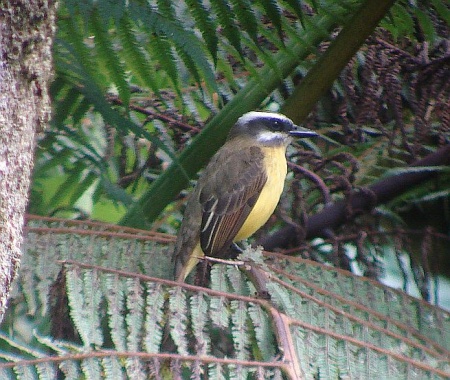- Myiodynastes hemichrysus
Identification
Length 18–20 cm
A large flycatcher with bright yellow underparts, most easily distinguished from other similar flycatchers by the dark stripe between throat and lower cheek.
- Upperside greenish olive
- Wings with rufous edges to inner primaries and outer secondaries, and yellowish on inner secondaries. Rufous also on some coverts and tail feathers.
- Underside yellow with whitish throat
- Breast and to lesser extent flanks have indistinct darker streaks
- Head mostly dark, with white supercilium and cheek-stripe.
- Semi-concealed yellow to orange crown stripe
- Prominent bristles at base of bill
- Eyes brown
- Bill black and prominent
Similar Species
Boat-billed Flycatcher (bill shape similar but wider), Great Kiskadee, White-ringed Flycatcher, Social Flycatcher, Gray-capped Flycatcher.
Distribution
Central and South America: found in Costa Rica, Panama, Colombia, Venezuela, and Ecuador.
Taxonomy
Two subspecies were formerly considered part of Golden-crowned Flycatcher.
Subspecies
Three subspecies are recognized[1]:
- M. h. hemichrysus:
- Montane forests of Costa Rica and western Panama (east to Veraguas)
- M. h. minor:
- M. h. cinerascens:
- Andes of northern Colombia and coastal cordillera of northern Venezuela
Habitat
Middle elevation wet forest, particularly near water courses, roads, and other places where the forest is a little more open or edge-like. Found at middle levels of central cordilleran mountains between 800 and 2300m.
Behaviour
Usually seen in pairs or small family groups.
Diet
Their diet consists mostly of fruit and insects which are captured by gleaning from surfaces of the leaves and branches of the tree.
Vocalisation
Dawn song is a phrase consisting of one strongly sounding note followed by a few more subdued, lower pitch notes. During the day, the common sound is similar to a kid squeezing a rubber toy about once a second. A third sound is a chatter with squeaky double notes.
References
- Clements, J. F., T. S. Schulenberg, M. J. Iliff, T. A. Fredericks, J. A. Gerbracht, D. Lepage, S. M. Billerman, B. L. Sullivan, and C. L. Wood. 2022. The eBird/Clements checklist of Birds of the World: v2022. Downloaded from https://www.birds.cornell.edu/clementschecklist/download/
- Gill, F, D Donsker, and P Rasmussen (Eds). 2023. IOC World Bird List (v 13.1)_red. Doi 10.14344/IOC.ML.13.1. http://www.worldbirdnames.org/
- Greeney, H. F., J. A. Mobley, and P. F. D. Boesman (2022). Golden-bellied Flycatcher (Myiodynastes hemichrysus), version 1.1. In Birds of the World (S. M. Billerman, B. K. Keeney, P. G. Rodewald, and T. S. Schulenberg, Editors). Cornell Lab of Ornithology, Ithaca, NY, USA. https://doi.org/10.2173/bow.gobfly1.01.1
- BF Member observations
Recommended Citation
- BirdForum Opus contributors. (2024) Golden-bellied Flycatcher. In: BirdForum, the forum for wild birds and birding. Retrieved 20 April 2024 from https://www.birdforum.net/opus/Golden-bellied_Flycatcher
External Links
GSearch checked for 2020 platform.1






